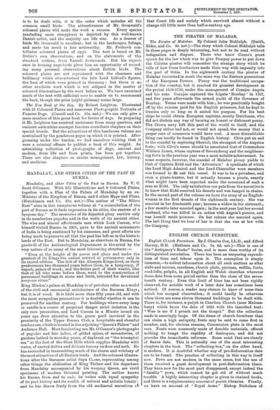MANDALAY, AND OTHER CITIES OF THE PAST IN BURMA.
Mandalay, and other Cities of the Past in Burma. By V. C. Scott O'Connor. With 235 Illustrations and 8 Coloured Plates, together with a Plan of the Palace of Mandalay by an ex- Minister of the Kingdom of Burma, and 6 other Maps and Plans. (Hutchinson and Co. 21s. net.)—The author of "The Silken East" aims in this sumptuous volume at "a, resuscitation of the past of Burma as it finds expression in its cities, the centres of a byegone day." The memories of its departed glory survive only in its numberless pagodas and in the walls of its ancient cities. The wise and almost affectionate care which Lord Curzon, who himself visited Burma in 1901, gave to the ancient monuments of India is being continued by his successor, and great efforts are being made to preserve all that the past has left us in the historic lands of the East. But in Mandalay, as elsewhere in Burma, the goodwill of the Archaeological Department is thwarted by the very nature of so many of the most interesting structures :— "Even at the height of its power and glory and under the greatest of its Kings tho nation arrived at permanence only in its sacred edifices. The last of the Alompra Kings lived, as their predecessors two thousand years before them, in a temporary, if superb, palace of wood; and the better part of their wealth, like that of all who came before them, went to the construction of permanent buildings in stone and brick, intended for devotional purposes alone."
King Mindon's palace at Mandalay is of priceless value as a model of the civil and ceremonial architecture of the Burman Kings ; but it is of wood. It is little more than fifty years old, and with the most scrupulous precautions it is doubtful whether it can be preserved for another century. For buildings where every lamp or candle is a source of perpetual danger strict isolation is the only sure precaution, and Lord Curzon in a Minute issued six years ago drew attention to the grave peril involved in the proximity of the Upper Burma Club, a hospitable and cheerful rendezvous, which is located in the adjoining " Queen's Palace " and Audience Hall. Most fascinating are Mr. O'Connor's photographs of pagodas and fair ladies, of gilded spires, of monasteries, of gardens bathed in noonday peace, of daybreak on "the triumphal sea" at the foot of the Shan Hills which supplies Mandalay with water, of carved deities and delicate tracery on door and arch. He has succeeded in transmitting much of the charm and witchery of the most attractive of all Eastern lands. And the coloured illustra- tions after the Burmese artist Sap. Clone, representing among other things the abdication of King Thibaw and his departure from Mandalay accompanied by his weeping Queen, are vivid specimens of modern Oriental painting. The author knows his Burma from end to end ; he writes with equal sympathy of its past history and its wealth of natural and artistic beauty ; and he has drawn freely from the old mediaeval narratives c,f that Court life and society which survived almost without a change till little more than half-a-century ago.










































































 Previous page
Previous page